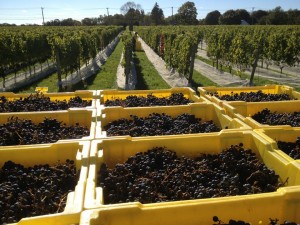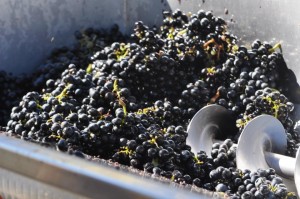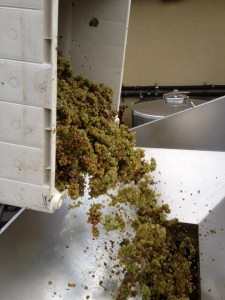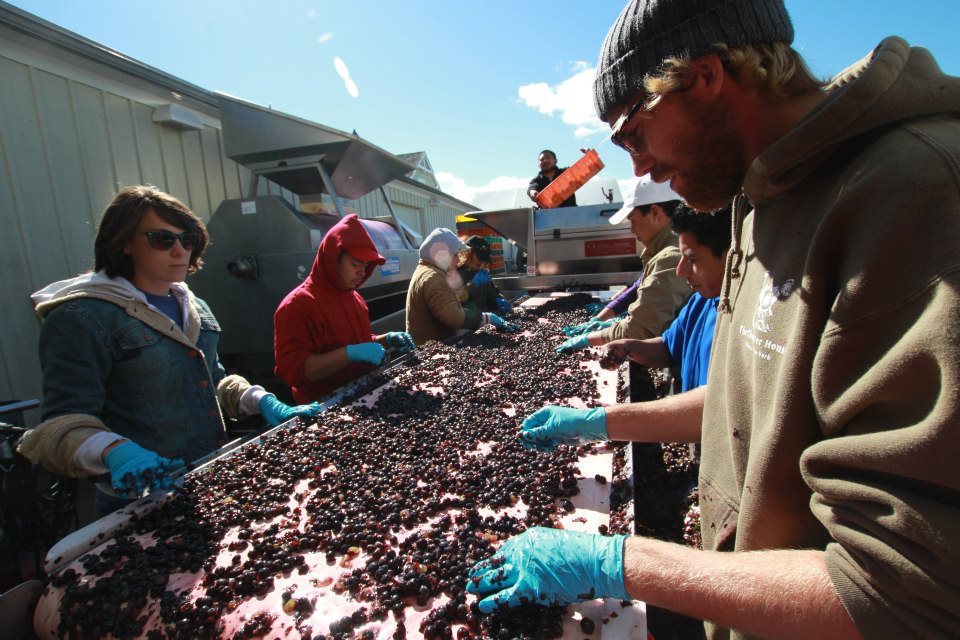
Writing harvest and vintage reports is always — shall we say, interesting? I hope that none of my winemaker or winery owner friends take offense, but I know that — nine times out of ten — what they tell me about the current growing season or most recent harvest cannot be taken precisely at face value.
Not that anyone would flat out lie to me, mind you, but there is little benefit to lowering expectations or panning a vintage. No matter the quality of the vintage, wineries need to sell those wines to stay in business.

The NYCR has a distinct advantage over most other publications when it comes to these reports though — we have people living in the regions, living the growing season first-hand.
Here on Long Island, a warm spring brought early budbreak in early April. Exact dates varied from site to site, but some vineyards reported their earliest budbreak on record.
As the warm, frost-less spring continued, some dared whisper that 2012 could be “another 2010” and for a while, it seemed to play out that way. Summer brought copious heat and sunshine. There was some rain here and there, but that helped mitigate some near-drought conditions later in the summer in some vineyards.
This is Long Island, a maritime climate, and that means humidity. Powdery mildew — always a concern — took over an entire quadrant of my home garden, and it forced some vineyards to spray more than they would have preferred. The timing of those sprays, leaf pulling, etc. was paramount.

Mildew or no, fo much of the summer, it seemed like a “another 2010” might be possible — until summer started to become fall.
It rained more. Botrytis and other rot bloomed in many vineyards. Rain storms and, eventually, Hurricane Sandy, impacted picking decisions, particularly with red wine grapes.
That classic Long Island hang time — which can extend well past Halloween some years, generating every last bit of possible ripeness — wasn’t possible for most in 2012. And, as with any year marked by rot issues, sorting both in the vineyard during picking and in the winery will likely be what separates the ‘great’ from the ‘good’ wines from 2012.

I have yet to taste any 2012 reds in tank/barrel (that’s coming in January I hope) but I have a feeling we’re going to see a return to a bit more “Long Island-ness.”
2010 was hot and dry and resulted in wines higher in extract and higher in alcohol. 2012 will turn the clock back a bit. Despite the inconsistent end to the season, that early start meant that grapes got ripe in terms of flavors and tannins — so I don’t think we’ll see many wines tasting of bell pepper — but lower sugar levels mean we’re not likely to see red blends up over 14% abv.
But enough of my thoughts. Let’s let the winemakers and winery owners share their own thoughts.
Kareem Massoud, winemaker, Paumanok Vineyards
2012 was an excellent vintage for Paumanok. Yields were good and quality was high across the board. 2012 was a very warm vintage but the heat accumulated over the growing season did not necessarily translate into higher sugars and resultant higher alcohols. The vintage yielded wines that are moderate and balanced with great fruit and focus. The whites are moderate in alcohol and higher in acidity, as we prefer. And the reds, especially cabernet sauvignon, are higher in alcohol and achieved a thorough phenolic extraction, i.e., soft, generous tannins.
You know how this goes we only have good vintages and great vintages!
I am beyond ecstatic about 2012. We had a very successful season. Our yields were exactly as estimated. The fruit quality and ripeness exceeded our expectations. Sour rot and botrytis were a non-issue. Clusters were looser and the berries were smaller than average.
Russell Hearn, owner/winemaker, T’Jara Vineyards and Suhru Wines
2012 is a ‘very, very good year.’
Our expectations were very high after such a warm and dry summer. Harvest started early, as was the case in 2010 and proceeded similarly till a week of rainy weather in the last week of September. By then most of the whites were off (except Chardonnay). This rainy period stalled the Red grape varieties development and required several additional sprays that we were hoping not to have needed.
Suhru Wines:
- Pinot Grigio came in super ripe! Even in 2010 it was not as ripe as this year. Brix 23.1, pH 3.23 and acidity of 6.01 grams per liter. Great fruit intensity my goal has been to maintain the bright acidity that this wine is known and enjoyed for. We will be bottling this early (beginning of January) to retain the vibrancy of the fruit.
- Riesling also was harvested much earlier than normal (last week of September). We had a small amount of ‘sweet botrytis’ on some of the clusters which I saw as a benefit. Sugars were not as high 21 brix, as this is a dry Riesling that is a positive, as it maintains a medium alcohol 12%. Excellent fruit ripeness
- Shiraz was delayed by the rainy period we experienced late in September. Sugar accumulation stalled however I am very happy with the fruit richness. Our style is to accentuate the fruit forwardness of this variety therefore pressing very early (at or near completion of the primary fermentation). The secondary Malo-lactic fermentation was done in barrel and has proceeded quickly. Our initial observations are very high on this wine, the only negative is yields were low so we will end up bottling a little less.
T’Jara Vineyards;
- Merlot and Cabernet Franc yields were below normal which moved there ripening forward to mid-month versus typically the last week in October. Both varieties seed development was excellent which allowed the ability to extend the maceration on skins substantially. Great color and fruit flavors are showing in both wines.
- Cabernet Sauvignon and Petit Verdot were harvested on October 19th to be off the vine before the hurricane. They are showing well however in the perfect world would have benefited from another 7-10 days on the vine. This slightly earlier harvesting forced my hand on a shorter maceration though both these varieties are blenders so it is less critical.
In summary I am very happy with the quality from the 2012 harvest and both a Reserve and Merlot will be very easy to produce from this harvest. The only negative was the smaller than normal yields.
Juan Micieli-Martinez, winemaker, Martha Clara Vineyards
2012 was an incredible year for me on a personal level, but a great year for the vineyard as well. Hurricane Sandy was definitely a damper, but we were picked by that point. We got very lucky with Sandy. If Sandy happened in early October vs. late October the content of this email would have been very different.
Peter Carroll, owner, Lenz Winery
Short version: Anyone who says 2012 will be the vintage of the century will be lying!
Rich Olsen-Harbich, winemaker, Bedell Cellars
What a year it was! A year that started early and ended early with ripeness levels not seen since the great vintage of 2010. All varieties came in extremely ripe and flavorful – from the Chardonnay to the Petit Verdot – we have bold and beautiful melodies coming from every tank.
For the past three years in row, Long Island vineyards have finished harvesting fruit before the end of October - something that in the previous 20 years was unheard of.
Another interesting phenomenon we witnessed this season is the increasing importance of ultraviolet (UV) light penetration. We saw almost identical levels of warmth (calculated as Growing Degree Days) in 2012 as we did in 2011 — but the two years couldn’t be more different from each other. While the reds from 2011 showed themselves to be more delicate and less extracted, the 2012 reds generated higher sugar levels and are already showing much more intensity and power.
The difference? 2012 had a far greater number of clear sunny days than 2011, as well as much less rain. During the growing season (March 1 – Oct 31) of 2011, we accumulated about 35 inches of rain — in 2010 we had 28 inches. As of Oct 24, 2012 has seen about 25 inches of rain — the lowest of the three. The lesson here? Great vintages are not always about heat but the confluence of heat, sunlight and dry weather that lead to truly extraordinary wines. We had enough of all three this season and the quality in the tanks shows.
The season took off in early April after a mild, almost non-existent winter. The vines grew quickly and the sunlight and heat worked together, bringing some fruit to maturity as early as September 1. The cool and dry days of late September and early October allowed the fruit to race across the finish line, with sugars rising quickly and maturity levels advancing rapidly by the day. Some days the grapes seemed to jump out and sing to us that they were ready. The final reds were picked in a fury, with our crew working hard to avoid the oncoming rains. The results were amazing and now we can take care of the bubbling wines inside our tanks and barrels over the next several months.
I’m so excited about the wines we have in the tanks right now. The whites are full of vibrant aromatics and zesty acidity, the roses are lush and flowery with waves of saline minerality and the reds are dark, bold, and velvety, with lovely savory, gravelly depth and lots of earthy spiciness. All of them sing loud and clear and represent what the North Fork can do best — and I can’t wait for you to try them.
Kelly Urbanik, winemaker, Macari Vineyards
2012 started with a mild winter and warm spring temperatures. Bud break was early, and the stage was set for a great growing season. The vines jumped out of the gate with a healthy, abundant fruit set. We enjoyed dry, warm weather throughout the summer. Our harvest season began on August 29 with Pinot Noir for our sparkling program and Chardonnay for our Early Wine.
We continued picking Sauvignon Blanc and Chardonnay at a relaxed pace, taking our time to pick the blocks at different ripeness levels to create optimal blending components. The 2012 whites are very high quality across the board, featuring great aromatics and beautiful natural acidity levels. I am especially excited for this year’s Sauvignon Blanc blend. We brought in our largest crop to date of beautiful and acid-driven Sauvignon Blanc fruit. We continue to believe that this variety is a great fit for our region.
We started the red harvest on October 10 with Merlot and continued picking at a steadily increasing pace until we reached the finish line on October 27 with Petit Verdot. We were able to get all of the fruit safely into the winery before Hurricane
Sandy hit Long Island.
Scattered rain showers during the final leg of ripening made the red harvest a little tricky. Despite these challenges, we were still able to reach our goals for ripeness and flavor development. All of the reds are now heading to barrel, and there is a wonderful balance amongst the wines. Some are fruit-forward, round and juicy. Others have more intensity, with lush tannins, earthy complexity, and excellent structure. I am happy with what I taste, and these wines will continue to develop and improve in barrel.
Edward Lovaas, winemaker, Pindar Vineyards/Duck Walk Vineyards
I noticed that acids were very low this year. Merlot out of all the reds came in the best. Whites looked very good and had a little better balance than reds but still the whites were what I would consider low acid levels in reference to sugar levels.
This is only my third harvest on Long Island and I would rate harvest over those three, best-to-worst: 2010, 2012, 2011 as I am sure most would agree.
Tom Drozd, winemaker, Pellegrini Vineyards
The 2012 Vintage has every potential to be an outstanding one. All fruit was picked earlier than normal due to the an early bud break which continued into a warm summer growing season. At Pellegrini hand picking allowed us to bring in some of the highest quality fruit that I have seen since 2010. Chardonnays had great concentration of flavor and more than adequate brix levels. Reds, especially Merlot, arrived at the winery with intense dark fruit flavors and sugar levels above 23 brix.
Without a doubt, there were some challenges in the vineyard, but I will have to tip my hat to the vineyard team for overcoming them and delivering some excellent fruit to the crush pad.
Although, in its infancy, I anticipate this to be a great year for Pellegrini and look forward to the development of these wines as they age in our cellar.
Gilles Martin, winemaker, Sparkling Pointe
With its earliest ever seen bud break 2012 harvest started on August 24 — even earlier than the superb 2010 Vintage. Sparkling Pointe first harvested 2- and 3-year old pinot noir from our new planting from our RT. 25 Vineyards in Southold.
The fruit came in very rapidly with perfect balance due to the great weather and warm temperatures. The yields were average due to a mild frost in the spring which brought a nice concentration of flavors in the fruit. The overall quality for this vintage is superb this vintage will allow to not only produce our regular program methode champenoise wines such as the brut, blanc de blancs, and topaz imperial (brut rose’) we will also be producing our Tete’ De Cuvee or Brut Seduction series from the 2012 harvest.
Greg Gove, winemaker, Peconic Bay Winery
Most of the 2012 growing season was similar to 2010 as far as early bud break, heat and lack of precipitation are concerned. We had bud break on April13. It was unseasonably warm in May, and the lack of precipitation in June made flowering and fruit set proceed without any problems. The hot, dry conditions in July required us to irrigate our young viognier and sauvignon blanc vines. This same weather continued through August and made this part of the growing season look like another 2010 vintage was in store.
Early September proved this assumption incorrect. Significant rain and cooler temperatures slowed down the ripening of the red grapes. The white grapes were still doing well. We had them all in by October 1. The sugar levels were evidence of the desiccation from the warm summer months.
Our sauvignon blanc came in at 23 brix while the viognier and chardonnay were 22.4 and 22.2 respectively. The aromas during fermentation and varietal aromas following fermentation show a lot of depth.
Soon after the whites were in we had a low pressure system descend upon us. It didn’t bring much rain — but the week of wet weather and lack of sunshine helped to promote mildew. While our malbec and petit verdot were unaffected, the merlot skins started to break down. We had to go through the painstaking, labor-intensive task of removing compromised berries from each cluster.
I believe 2012 will prove to be far superior to 2011. As we saw in 2005, it’s hard to neutralize a hot dry growing season with inclement weather in the fall. The color intensity and flavor of the 2012 reds are proving this point.

